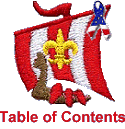
|
||
|
|
Scouting History in the Viking Council 1910-1976
|
|
Cover 1 2 3 4 5 6 7 8 9 10 |
|
Scouting in America traces its origin to a concept developed by Sir Robert S.S. Baden-Powell (later Lord), of Gilwell Park, in Epping Forest near London, England, while a Lieutenant General in the British Army during the South African War. He found that the ordinary process of military training was not completely effective as it did not teach men how to care for themselves. They lacked fundamental character values such as dependability, initiative and resourcefulness.
He therefore, set out to seek a better method. As he developed his theory, he put his thoughts together in a manual that he called "Aids to Scouting." It was in this book that he first described the idea pf dividing the men into patrols of six or eight so that the leader might have close personal contact with them - one of the fundamental principles of Scouting.
When he returned to England from Africa in 1908, he learned that his program for men was being adopted and used in English schools for boys. Baden Powell then refined his program to better fit young men.
His idea of training boys was that they should organize themselves into small natural groups under a boy leader - the patrol and the patrol leader. Their training would be complementary to their regular education - such things as mapping, signaling, knotting, first aid and all the skills used in camping and similar outdoor activities.
But, most important of all, to become a Scout a boy must promise that on his honor he would do his best to do his duty to God and his country, to help other people at all times, and to obey the Scout Law, a simple code of chivalrous behavior easily understood by the boy.
Another of the basic Boy Scout principles was the "Daily Good Turn," which was avidly embraced by the boys and their leaders, and which captivated the general public.
Progressive training of the adopted skills related to outdoor life and pursuits resulted in greater proficiency, and when an established standard was achieved, the Scout was rewarded with a specific Merit Badge. From the beginning the left handshake, together with the Fleur-de-Lis and the motto "Be Prepared" were adopted as the sign of being a Boy Scout. In 1916, the Congress granted a special Federal Charter protecting the name and insignia, and limiting membership to American Citizens.
|
|
Cover 1 2 3 4 5 6 7 8 9 10 |
|
|
The
ScoutingBSA.org web site is a
legacy site of the Viking Council BSA, now Northern Star Council.
|
|
||||||
Last Update May 15, 2023

.jpg)